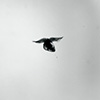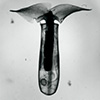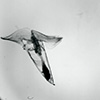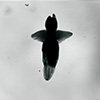College of Engineering News Room
Tracking the Movements of Sea Butterflies and Oil Spills

Limacina bulimoides

Cuvierina columnella

Hyalocylis striata

Pneumodermopterid
By Brad Stager
David Murphy studies how sea butterflies "fly" through water so miniature robots capable of traveling through air as well as underwater can be developed.
"We're trying to draw design inspiration from these swimming creatures," says Murphy. "They have figured out elegant solutions to really difficult engineering problems, so we're trying to capture those ideas."
It is research that Murphy conducts through the Murphy Fluids Lab he established upon joining the College of Engineering's Department of Mechanical Engineering faculty as an assistant professor in the fall of 2016.
"We're trying to gain inspiration from biology to solve human problems," says Murphy, who characterizes his work as the nexus of fluid mechanics, biology, ecology and the environment.
Fluid mechanics and animal biomechanics have characterized Murphy's scientific inquiries since he was a Birmingham, Alabama high school student competing in science fairs, twice at the international level of competition. For one project, he built a working, metal model of a manta ray that replicated the marine creature's fin movements.
"I was always about science fairs as a high school student," he says. "It was great being around other kids who thought science was cool."
Murphy's continuing interest in engineering and biology is reflected in his academic accomplishments, including earning a double BS in Mechanical and Biomedical Engineering from the University of Alabama at Birmingham. He followed up with an MPhil in Biological Science from Cambridge University and then went on to earn an MS in Mechanical Engineering from the Georgia Institute of Technology in Atlanta, Georgia, where he also earned his PhD in Civil and Environmental Engineering.
His research on the movement of different species of sand-grain sized (.5 to 3 millimeters),
wing-footed marine snails, commonly known as sea butterflies, includes measuring the
motion they generate and measuring the flow they produce.
By positioning two high-speed cameras at right angles to each other to record an aquarium
full of the snails, Murphy and his team saw they create motion by clapping their wings
together at the end of the upstroke and flinging them apart at the beginning of the
downstroke. The same technique is used by tiny flying insects such fruit flies, the
main difference being that the snails are creating lift with water instead of air.
But according to Murphy it all comes down to fluid dynamics.
"They're basically flying through the water," he says. "The fluid dynamics of sea butterflies moving through water is the same fluid dynamics of small insects flying through air."
Murphy first became interested in the planktonic sea butterfly Limacina helicina while researching zooplankton for his PhD. Intrigued by the sea snail's fluid mechanics, his advisor arranged cross-country shipments of them from the Pacific Northwest to their lab at Georgia Tech.
One problem that quickly became evident he says, is the fragility and resulting high mortality rate of sea butterflies once they have been brought into the laboratory.
"They're difficult to study because they don't do well in captivity, so that really puts some constraints on trying to understand them."
Murphy decided to take advantage of USF's close proximity to warm-water marine environments that are home to sea butterfly species such as the cone-shaped Hyalocylis striata.
Earlier this year, Murphy Fluid Lab team members traveled to the island of Bermuda, home to the Bermuda Institute of Ocean Sciences (BIOS), to work with Amy Maas, a researcher at the institute who has expertise in working with sea butterflies.
"She is an expert on sea butterflies and different aspects of their biology," says Murphy, who adds that the waters around Bermuda offer many species of sea butterflies to examine.
Ferhat Karakas, Murphy's first graduate student, and Joseph Bello, an undergraduate research assistant, joined Murphy on the trip and say they gained experience that will help them achieve their academic and professional goals.
According to Ferhat, who has an MS in Aerospace Engineering, working with the sea butterflies validates the connection between nature and human design.
"Nature is always inspiring engineers as you know," he says, adding that understanding the fluid mechanics of marine mollusks "Could inspire a new generation of flapping-wing micro air vehicles that are capable of operating in both water and air."
Mechanical Engineering undergraduate student Joseph Bello also traveled to BIOS and provided his nautical know-how that he gained from recreational sailing, as well as an enthusiasm for the hard work that sometimes goes along with research.
"At sunset, a marine biologist and I would leave the dock to draw nets, collect pteropods, and sift through the different sea creatures on the boat," says Bello. "When we came ashore, buckets and coolers containing the creatures were brought into BIOS where another marine biologist and I further separated the sea butterflies from other organisms that were caught in the nets."
Studying the fluid dynamics and movement of sea butterflies has earned Murphy and Maas the financial support of the National Academies of Sciences Keck Futures Initiative for their project, "Swimming in Sea-Butterflies: Physics, Physiology, Ecology, Art, and Design Inspiration for an Aquatic Micro-Aerial Vehicle." Samantha Newton of Oregon State University is a Co-Investigator for the project.
According to the NAKFI website, the project will "examine the physics and ecology of this (sea butterfly) motion to inspire midwater ocean conservation and to design a micro-aerial/aquatic vehicle."
During the same NAKFI funding cycle, Murphy is a co-investigator with another group of researchers who received money for "Creating Resilience: Building a Gulf of Mexico NAKFI Alumni Working Group."
Murphy also has conducted research related to offshore oil spills. While it is common knowledge oil and water don't mix, Murphy considers how the two substances interact in a given situation, such as the 2010 Deepwater Horizon oil spill and its aftermath.
"When you have an oil spill, the dispersion of oil is a fluid mechanics problem," says Murphy, who also received an Early-Career Research Fellowship from the Gulf Research Program of the National Academies of Sciences, Engineering and Medicine.
Some of the related areas in which Murphy has conducted research include what happens when aerosol is produced from rain falling on oil-contaminated water and how currents affect application of dispersants and crude-oil jets that are released from the sea floor.
Kendra Daly, a professor of USF's College of Marine Science and director of the Zooplankton Ecology Lab is Murphy's Mentor for the early-career grant. Her role reflects the importance that a resource such as the College of Marine Science has for a researcher like Murphy who wants to do more work in the field, or on the water.
"Working with the College of Marine Science is going to be extremely helpful," he says. "The researchers there have the expertise of going to sea and designing equipment that can stand the rigors of the marine environment."
Murphy says he plans to grow his lab, which has recently added new members. Paola Rossi and Daniel Olsen are both working on their Bachelor of Science in Mechanical Engineering degree. Among the attributes Murphy says he looks for in his research associates is "a willingness to get their hands dirty."
Learn more about the Murphy Fluids Lab and its work in researching sea butterflies and oil spills.